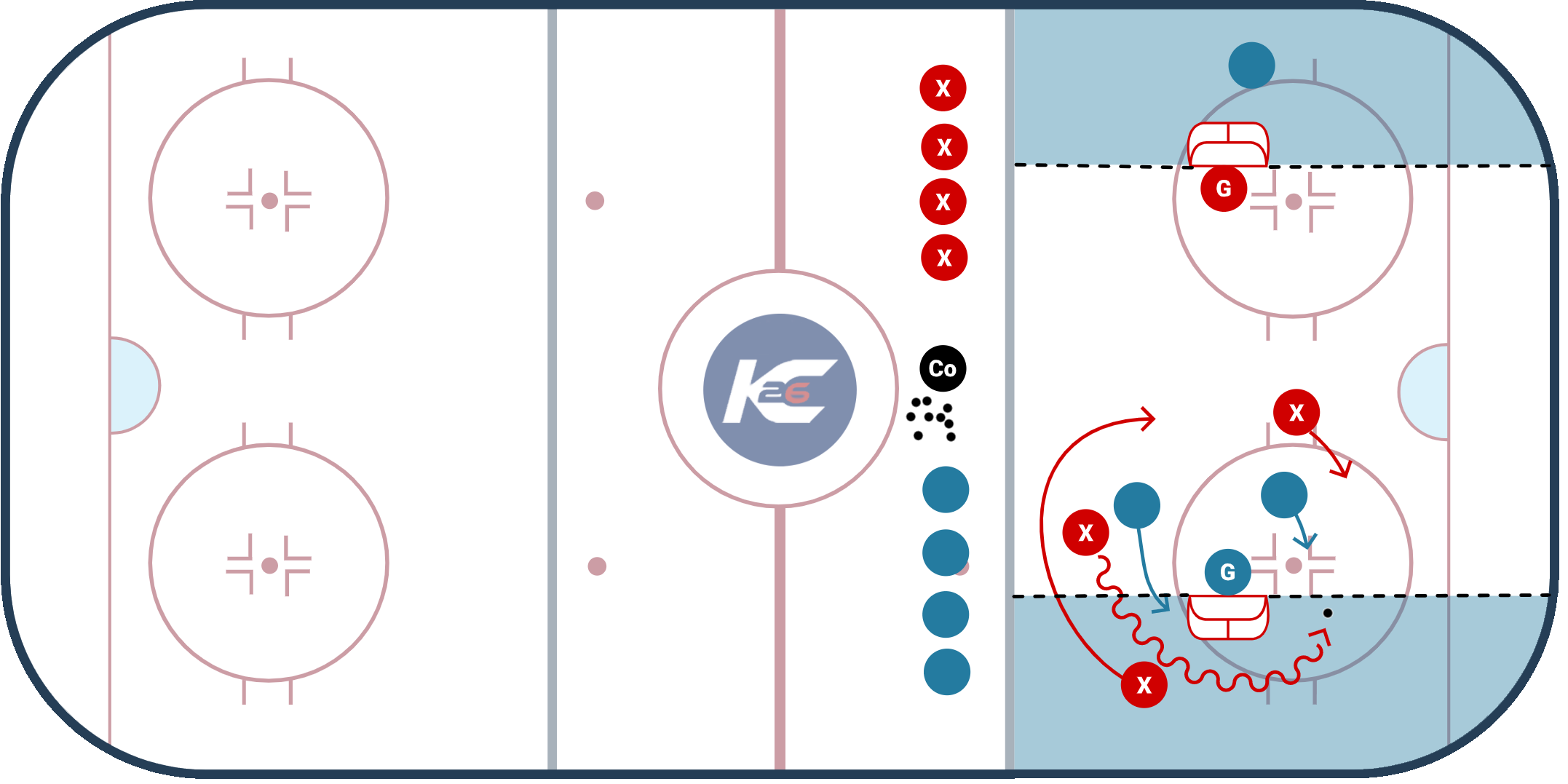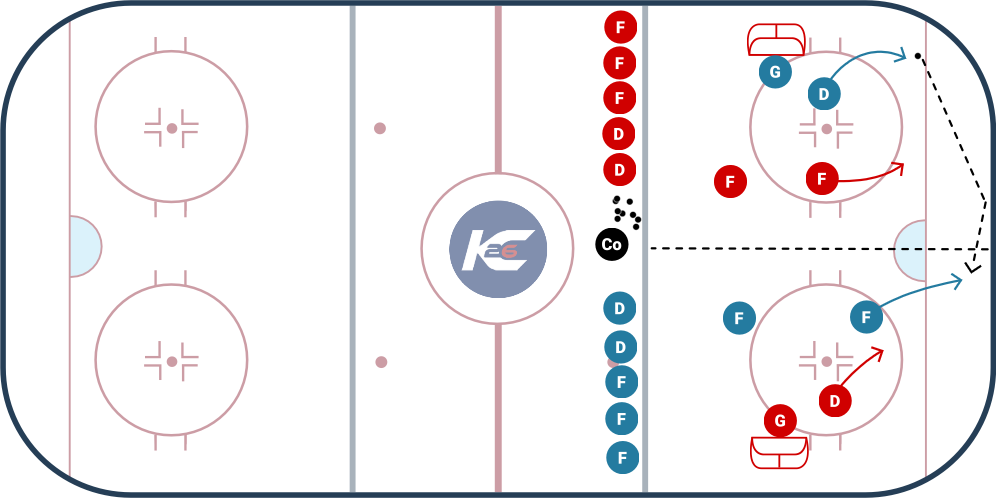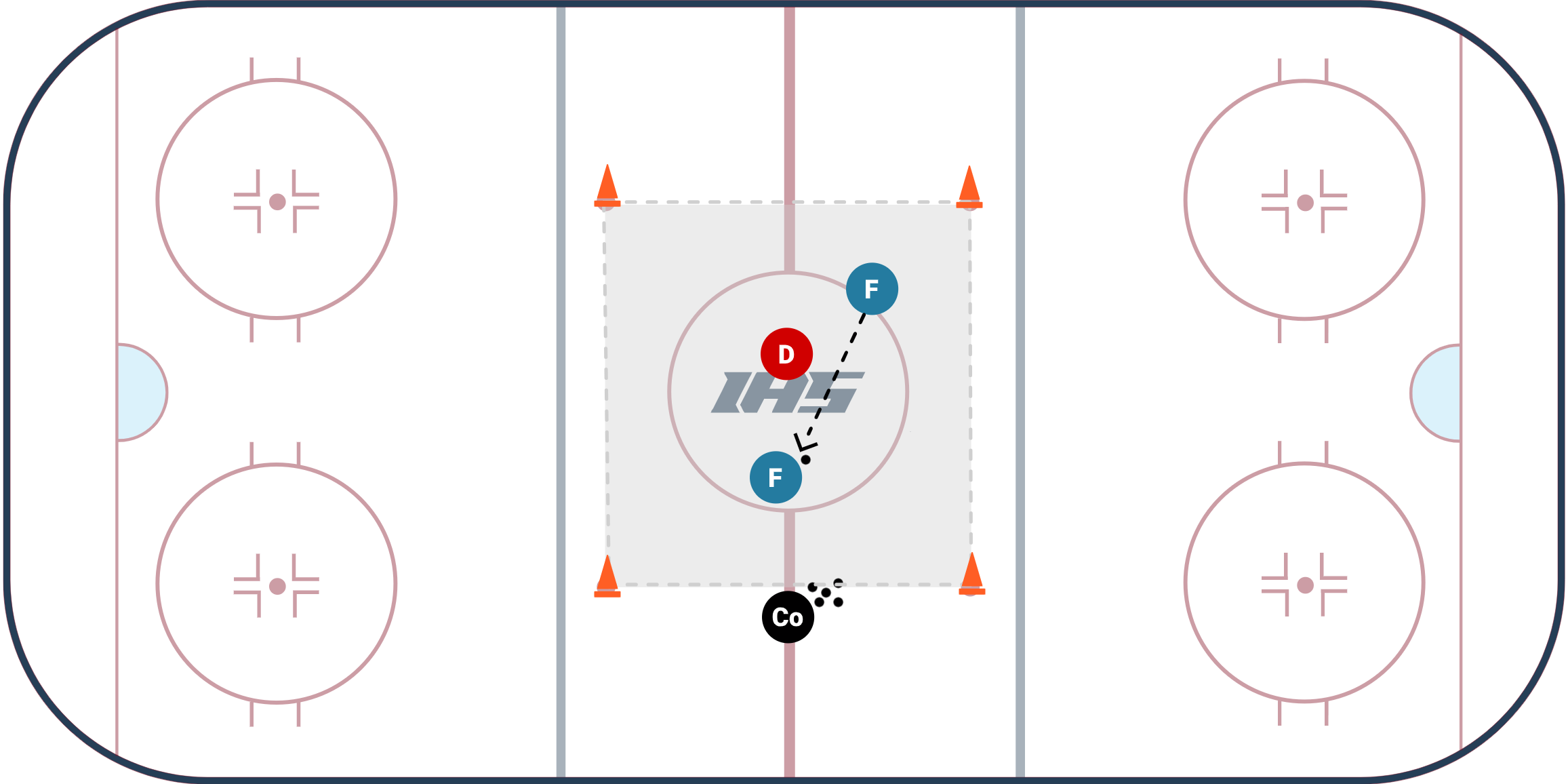
Puck Support in 2 v 1 Situations
Puck Support in 2 v 1 Situations

Please Note: The Practice of the Week is designed to bring value across multiple age levels. You can use this to build ideas to develop your own practice. With that being said, we highly encourage you to adjust the drills based on your team's age and skill levels. IHS should always be used as a starting point and you can add/remove constraints to fit your team.
Practice Theme: 2v1 situations happen all over the ice. This practice plan is focused on puck support & capitalizing in different 2v1 situations
The 3 Key Focus Points
- Finding Open Ice - encourage players to find open ice and create passing lanes for their teammates. Pass & Move - don't stare at your passes
- Communication - encourage your players to use verbal and non-verbal communication to let their teammates know they are open
- Exchanges/Switches - try to get your players to work on some basic exchanges/switches and show them how it creates time and space
A lot of players stare at their passes, encouraging your players to Pass & Move is a great start to developing more space and opportunities in these situations. Try to instill this mindset to get moving as soon as you pass to find open ice and become an option.

2 V 1 Quick Strike Game
Description
The 2 v 1 Quick Strike from Kendall Coyne Schofield is a great small area game for practicing quick developing 2 on 1's for both offense and defense. The game should have a lot of scoring and pace to it.
Set Up
- Set up 2 nets on the half wall in an offensive zone
- Draw a line (or place a few cones/tires) in the middle of the zone going from the blue line to the end boards (through the crease)
- Each side has 2 forwards, 1 defenseman and a goalie
- Players who are not in the 2 v 1 should keep the puck in along the blue line
Game
The objective of the game is to play up to a certain number, team "X" vs team "O"
- Coach passes a puck in or chips it in for a battle
- Forwards are trying to score
- Defense is trying to get the puck to their forwards on the other side of the ice to activate the 2 on 1
- As soon as the puck crosses over to the other side, the 2 forwards and defensemen clear out and 3 new players come in
- Players can go anywhere on their half of the ice
- If a goal is scored, the coach should reward the scoring team with another puck
- This game should be continuous, but the coach can dump in another puck if one clears the zone or the goalie freezes it
- Keep Score!
Variation
- After the defenseman transitions the puck to his or her forwards, they are allowed to activate and cross to the other side
- If this happens, then one of the forwards (from zone that was just cleared) can also activate, making it a 3 v 2
- This version is a little more skating and has more decisions involve
Coaching Points
- Quick shots and quick passes
- Players on the side without the puck should work to be an outlet for their teammate (get open, call for the puck and present your stick as a target).
- Defensive players need to keep their heads up and make quick decisions to transition the puck to their teammates

2 V 1 Puck Pursuit Angling
The 2 v 1 Puck Pursuit Angling drill helps offensive players work on forchecking principles, while defenders can work on retrievals and puck protection.
Setup
- Coach sets up an a net on the goal line and a tire out by the blue line.
- On the whistle, a coach, or a player, chips the puck behind the net.
- The defender retrieves the puck and works to wheel around the net, protecting the puck and trying to get past the tire in the blue line. If they are able to get past the tire, they are awarded 2 points.
- The 2 offensive players work to angle the defender, strip them of the puck, and attack the net. If the offensive team scores, they are awarded 1 point.
Coaching Points
- Offense:
- The first forechecker skates at an angle, keeps their stick on the ice, aims to go stick on puck, and check through the defenders hands, separating them from the puck.
- The second forechecker skates at more of a flat angle, and provides support to the first forechecker.
- Defense:
- Protect the puck and use deceptive skating and moves to try to throw off the players forcehcking and angling techniques.
Variations
- Coaches can set this up to be 1/4 setup (as shown) or 1/2 ice utilizing the full zone.

7 Pass 2 vs. 1 Small Area Game
This small area game that focuses on passing and moving without the puck. It appears to be simple but go ahead and give it a try with some elite level players and you will see them struggle, it is not nearly as easy as it looks.
Setup
Place a cone on each of the neutral zone face-off dots to mark the boundary. Two offensive players and one defensive player will be inside the playing area with the coach just outside the box with pucks. On the whistle, the coach will play a puck to the offensive players who will move throughout the playing area making as many passes as they can. The defender will try to break up the play and intercept passes and if they get the puck they can just shoot it out of the box. It the puck goes outside the box the coach plays a new puck to the offensive players right away. As players make completed passes the coach will count out loud each time a successful pass is made.
Objective
The offensive players try to make 7 consecutive passes (or 5 consecutive passes for lower age groups).
Goalie Variation:
- If you have a net and a goaltender, let forwards attack the net after 7 passes have been made. Goalies can work on tracking the puck with shuffles, t-pushes, and slides.
Coaching Points
- The key is for players to pass and move. There will be a tendency for players to pass and watch but this cannot happen in a small area.
- Remind players without the puck they have to help their partner by giving them a good target, moving and always being ready for a pass.
- Defensive players should have active sticks, stop and start, and skate in straight lines.

Decision Time 2 on 1
This drill works on decision making in a 2 on 1 situation. The drill is great for station based or ADM type practices as it requires only one quarter of the ice, but you can make it a half ice drill if you go out of both sides at the same time.
Setup
Place two lines of players as shown in the diagram and place a border or obstacle just inside the blue slightly higher than the top of the circle. A coach should be placed at about the dot.
The drill starts with P1 carrying a puck straight ahead into the zone and then making a sharp cut towards the middle in front of the pad. Player two also skates straight ahead and then makes a sharp cut towards Player 1 to receive a drop pass. Player 2 will receive the drop pass, go around the pad, and then make a decision to pass or keep the puck based on the coaches action. If the coach pressures Player 2 then they pass the puck. If the coach takes away the pass then player 2 carries the puck and shoots on net.
Coaching Points
- Players should make sharp turns so they are moving horizontally across the ice when making the drop pass.
- Drop pass should be to Player 2's forehand.
- Player 2 needs to have eyes on coach to read the situation.
- Make sure both players stop at net for rebound.
Variations
- Coach playing defense can be switched to be a player.
- You can allow the defense to be fully active.
- You can turn it into a 2 vs 2 with a backchecker (shown in video example).

Point to Half Wall 2 vs 1
The Point to Half Wall is an excellent small area game that helps players practice a 2 vs 1 in a small space along the boards. The game also reinforces important skills like keeping your head up, moving to open spaces, protecting the puck and communication.
The goal of the game is for the offense is to connect on 4 consecutive passes in a row. If they do so, they win and are allowed to shoot on net. If the defense takes the puck away, or the puck goes out of bounds 2 times during the game the defense wins and is awarded a shot on net.
Setup
- Playing Area: Use 4 cones or tires that create a triangle from the half wall to the middle of the blue line.
- Goalie Setup: This can be set up as a station with a goalie, or without. If you use a goalie it can be placed in the crease or the net can be moved so the drill is a station.
- Players: Alternate players. It is beneficial for players to get reps on both offense and defense sides.
- Passes: You can require 4 (or a different amount) of consecutive passes to win.
- Defense: If the defense is taking the puck away too much, you can tell the defense to flip their stick over.
- Winner: The winning side gets a shot on net. Other winning options are:
- If the offense wins:
- The last person with the puck gets a shot on net.
- Both players are given a puck and can shoot on different goalies.
- The game moves to a 2 vs 1 in front of the net and offense is allowed one shot if they can get it off.
- If the defense wins:
- They get a shot on net.
- The game moves to a 1 on 1 in front of the net and the defense is allowed one shot if they can get it off. The losing offense team needs to communicate with each other as to who is going to go after the defense.
- If the offense wins:
Coaching Points
- Use the boards! They are your friend!
- If used properly, the boards can be used as an extra player out there and are helpful for bank passes and puck protection.
- Offensive players need to protect the puck until they can make a play and then expose the puck to make a pass.
- Offensive players have to move without the puck. Think "Give & Go!"
- Defensive players are most successful with active sticks and stop and starts. There are no short cuts!
Progressions
- Have one of the offensive players be a "Point Player" who has to stay up around the blueline.
- This progression can be great for defenceman working on their puckhandling at the point & forwards becoming outlet passes.
- Create a smaller "playing area" to make it tougher on the offense.
- Play the Corner to Half Wall 2 vs 1.
Outside 2 on 1's
The Outside 2 on 1's drill from Brad Flynn allows teams to practice 2 on 1's on the outside of the ice.
Setup
- The drill runs out of both sides of the ice.
- Players are set up as shown in the diagram.
- On the whistle, the coach places a puck in the corner. The defenseman jumps out, pivots around the dot and retrieves the puck.
- At that same time, F1 times a breakout route, going low and slow as an outlet for the defensemen.
- After the defenseman hits F1 with a pass, F1 skates up the neutral zone and passes the puck to F2 (the forward along the boards).
- F1 stops at the blue line and jumps up ice with F2, which starts a 2 on 1 with the original defender that rushed to get up ice and gap up.
- The 2 on 1 continues along the outside of the ice.
Coaching Points
- Defender: keep head up and scan the ice as you retrieve the puck. This is a great opportunity to practice deception on your retrievals. Work to gap up properly on the 2 on1. Keep stick on the ice to eliminate passes.
- Forwards: go low and slow and present a good target during the breakout. On the 2 on 1, make sure to communicate with each other. Forward without the puck should always be an outlet to receive a pass, or consider driving the net to create space for the puck carrier.

Gretzky 2 V 2 Switch Game
The Gretzky 2 vs. 2 Switch game from Kendall Coyne Schofield is a great small area game that has a modification to the normal Gretzky 2 v 2 Game: the "Gretzky" behind the net can switch with active players at any point, so long as at least one player is behind the goal line. This modification allows more options for player to create offense and encourages exchanges and switches.
- In a half ice setup, place two nets facing each other in opposite face off circles.
- Have a 2 vs. 2 in the middle of the ice.
- Each team has 1 player behind the net in their offensive zone. They can not go in front of the net unless one of their 2 teammates activates a switch
- To start, coach can pass a puck, take a shot on net, or chip it in the middle of the ice for a battle.
- Keep score!
- Offensive players:
- Players in the middle of the ice: work on give and go's and exchanges with your teammates and your "Gretzky"
- Players behind the net: know where you want to pass to before you get the puck. Use the net as protection and get creative. Communicate with your teammates on opportunities you can create through switches
- Defensive players:
- Head on a swivel and know where all of the players are.
- Keep stick on ice to block passing lanes.
Variations
- Can be 2v2 or 3v3 in the middle of the ice
- Can allow 2 "Gretzky's"
- Can require players to only hold the puck for 1 or 2 seconds or a whistle is blown



